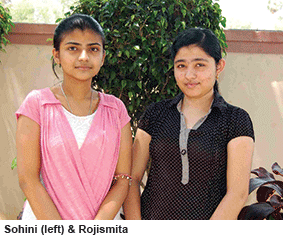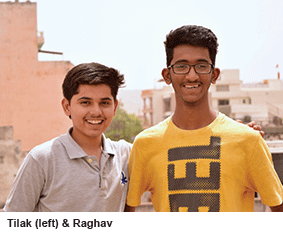 It’s raining encomiums for Sohini Karmakar and Rojismita Purohit, class XII science students of Visakhapatnam’s Vikas Vidyaniketan School (estb.1993) who cracked the annual Kishore Vaigyanik Protsahan Yojana (KVPY, youth sciences study incentive plan) scholarship exam of the Indian Institute of Science, Bangalore. Although the students were ranked #410 and #1,410, they are among the 1.5 percent of the 100,000 candidates countrywide who cleared the KVPY exam (the results of which were announced on March 22) and as such, are eligible to receive annual study grants of between Rs.80,000-112,000 for undergrad and postgrad study.
It’s raining encomiums for Sohini Karmakar and Rojismita Purohit, class XII science students of Visakhapatnam’s Vikas Vidyaniketan School (estb.1993) who cracked the annual Kishore Vaigyanik Protsahan Yojana (KVPY, youth sciences study incentive plan) scholarship exam of the Indian Institute of Science, Bangalore. Although the students were ranked #410 and #1,410, they are among the 1.5 percent of the 100,000 candidates countrywide who cleared the KVPY exam (the results of which were announced on March 22) and as such, are eligible to receive annual study grants of between Rs.80,000-112,000 for undergrad and postgrad study.
Given that both come from the interior district towns of Baripada and Sambalpur in Odisha where access to quality secondary education for girl children is restricted, this is a notable achievement. In 2013 they were admitted into the fully residential Vikas Vidyaniketan School, Visakhapatnam (Andhra) which offers an integrated CBSE and IIT-JEE/PMT test preparatory programme, and wrote the KVPY scholarship exam in November 2015. Vikas Vidyaniketan is among 58 schools promoted by the Hyderabad-based People Combine Educational Initiatives Pvt. Ltd.
Established in 1999 and administered by the Indian Institute of Science, KVPY is a scholarship programme funded by the Central government’s Department of Science and Technology to encourage school-leaving students to opt for science streams in higher education. The programme offers scholarship and contingency grants up to the pre-Ph D level to the top 1.5 percent of students who write the exam.
Sohini readily concedes that switching schools and the mentoring she received at Vikas Vidyaniketan helped her bag the prized scholarship. “Over the past two years since I moved to Vizag, my school has been a home away from home,” she says.
Likewise, Rojismita acknowledges that the switch to Vikas Vidyaniketan was a turning point. “I believe the integrated curriculum of the school is adequate grounding for any entrance exam,” she says.
The classmates are currently preparing intensively for admission into medical colleges countrywide. While Sohini wishes to study and research cardiology, Rojismita has set her sights on practising gynaecology.
Wind in your sails!
Paromita Sengupta (Bangalore)
A2Oz champions
The Load Distributor, a three-and-a-half-minute film which sends out a strong message of hope to the huge community of head-load bearers including railway and mountain porters, has won 17-year-old innovators Tilak Badaya and Raghav Kabra, class XI science students of the CBSE-affiliated Seedling Public School, Jaipur, first prize in the social entrepreneurship category of the A2Oz — Advance to Australia Schools Video Competition 2015. The jury’s verdict was announced on March 10. After besting 102 entries, the two teens are all set to travel Down Under on an all-expenses paid five-day study tour hosted by Bond University, Queensland.
Organised jointly by the Australian Trade Commission and Cambridge English Language Assessment in four categories — marine sciences, robotics, creative animation and social entrepreneurship — the A2Oz competition, which drew participation from 380 schools countrywide, required students to produce short films outlining their ideas to solve complex global challenges.
“Gazing out of our physics lab window, we often saw daily wage labourers carrying heavy head-loads at an adjacent construction site. Deliberating on the health hazards of their occupation helped develop our idea to reduce the stress and strain of this neglected community,” says Raghav.
Under the guidance of physics teacher Ashok Ramani, the duo devised an innovative model which effectively distributes the weight of head-loads to the shoulder and waist regions. Utilising two stout bamboo sticks, foam belts and a wire mesh, they have invented a device to spread the weight of head-loads over the rest of the body. “It took us less than a week to shoot the video,” recalls Tilak.
Childhood friends and classmates Tilak and Raghav are looking to file a patent for their low-cost device (price: Rs.110). “If our innovation finds its way to the market, it will help reduce the pain and prevent irreversible cranial nerve damage of millions of head-load carriers around the world,” says Raghav.
Wind beneath your wings!
Autar Nehru (Delhi)